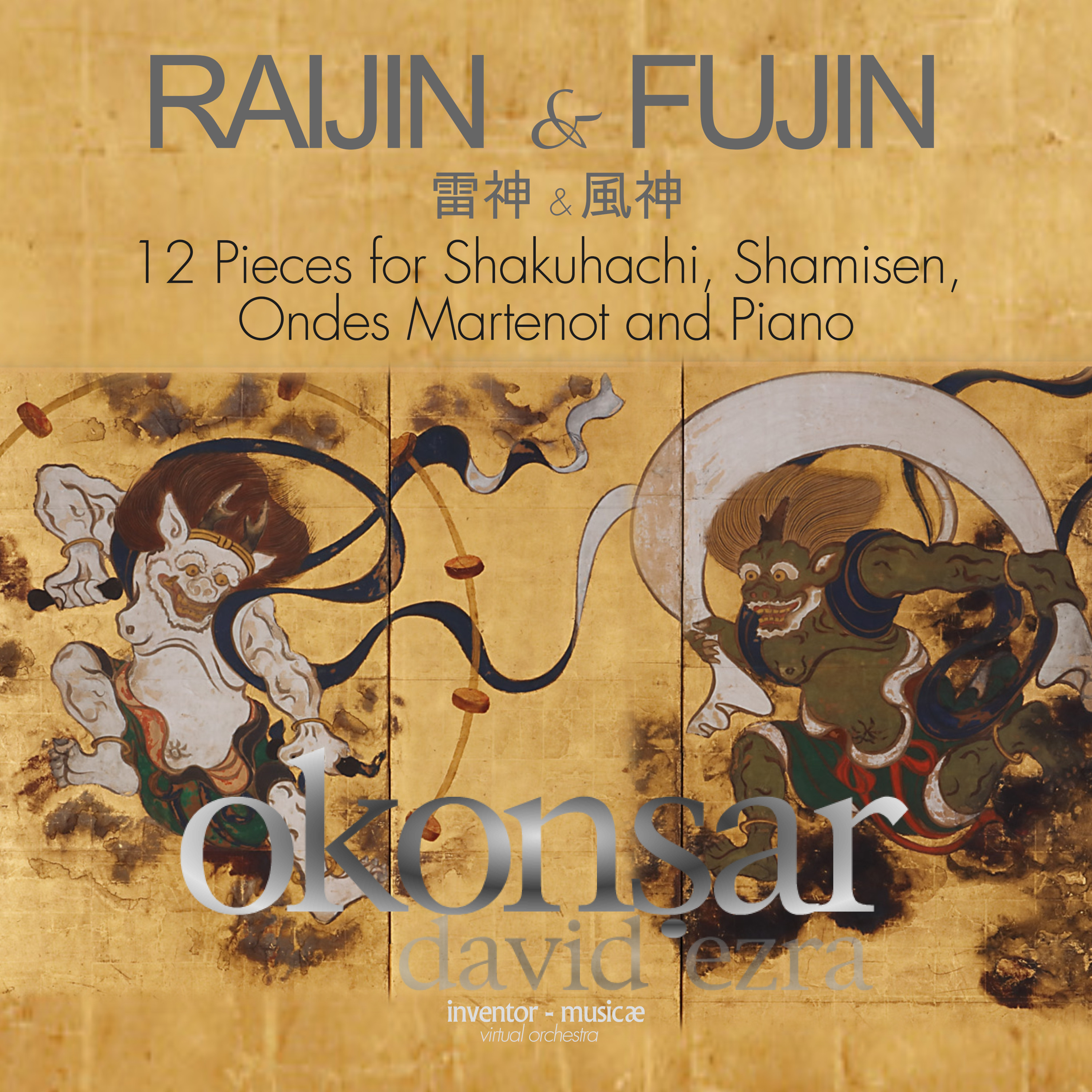
Downloads only. Physical CD not available.
|
Japanese mythology and Shinto beliefs are based on the idea that everything in nature has a spirit or god, known as a kami. This vision of life and nature is deeply rooted in Japan's cultural practices and traditions. The various gods are believed to influence all aspects of life, from changing the seasons to the success of crops and hunting. Raijin, the awe-inspiring god of thunder and lightning, stands as one of the most powerful kami in Japanese mythology. Legend has it that Raijin wields control over the weather through the rhythmic beating of drums. Fujin, the god of wind, complements Raijin's power by governing the wind. These two entities, believed to be brothers, are often depicted together, their combined might a source of wonder and intrigue. The artwork for this composition is Wind God and Thunder God (紙本金地著色風神雷神図) is a diptych artwork created with ink and color on paper that has been coated with gold foil. The artwork portrays Raijin, the deity associated with lightning, thunder, and storms in the Shinto faith and Japanese folklore, alongside Fūjin, the god of wind. Although the screens lack any inscription or stamp, there is no doubt regarding their attribution to Tawaraya Sotatsu (1570-1643). This artwork holds a significant position within the Rinpa school: one of the major historical schools of Japanese paintin, created in 17th century. Raijin and Fujin's dynamic relationship symbolizes the balance and harmony necessary for the natural world to thrive. In Japanese culture, these gods are not just figures of mythology but are revered and respected as forces that must be appeased and honored. For example, Raijin's control over thunder and lightning is seen as a powerful force that can bring both destruction and renewal, influencing agricultural practices and even the design of traditional Japanese buildings. Similarly, Fujin's influence over the wind is considered in activities such as sailing and farming. The deep connection between nature and spirituality in Japan is evident in the way these gods are intertwined with everyday life, shaping beliefs, traditions, and customs passed down through generations. The series of pieces Raijin & Fujin for piano, shakuhachi, shamisen, and Ondes Martenot by David Ezra Okonsar is a captivating exploration of this interconnectedness. With its enchanting arrangements and compelling harmonies, the music draws listeners in, offering a unique fusion of Eastern and Western musical elements that is sure to engage and enthrall. Okonsar's composition is a masterful blend of traditional Japanese instruments and Western contemporary classical elements. This unique fusion creates a captivating sound that mirrors the harmonious relationship between nature and spirituality in Japanese culture. The music's eerie soundscapes and evocative structures transport listeners to a realm where the gods of wind and thunder are not just mythical beings, but living forces that shape the world around us. Through this mesmerizing work, Okonsar captures the essence of Japan's deep-rooted connection to nature and its spiritual beliefs, inviting us to experience the beauty and power of these ancient traditions through the universal language of music. The music is audaciously new and yet somehow familiar, echoing the timeless wisdom of generations past. Its universal appeal transcends cultural boundaries, offering a unique opportunity for people from all walks of life to connect with the rich spiritual heritage of Japan. -------------------------------------------------- FR La mythologie japonaise et les croyances shintoïstes reposent sur l'idée que tout dans la nature possède un esprit ou un dieu, connu sous le nom de kami. Cette vision de la vie et de la nature est profondément ancrée dans les pratiques et traditions culturelles du Japon. On pense que les différents dieux influencent tous les aspects de la vie, du changement des saisons au succès des récoltes et de la chasse. Raijin, le dieu impressionnant du tonnerre et de la foudre, est l'un des kami les plus puissants de la mythologie japonaise. La légende raconte que Raijin exerce un contrôle sur le temps grâce au battement rythmique des tambours. Fujin, le dieu du vent, complète le pouvoir de Raijin en gouvernant le vent. Ces deux entités, considérées comme des frères, sont souvent représentées ensemble, leur puissance combinée étant une source d'émerveillement et d'intrigue. L'œuvre d'art de cette composition est Wind God and Thunder God (紙本金地著色風神雷神図) est une œuvre en diptyque créée avec de l'encre et de la couleur sur du papier recouvert d'une feuille d'or. L'œuvre représente Raijin, la divinité associée à la foudre, au tonnerre et aux tempêtes dans la foi shintoïste et le folklore japonais, aux côtés de Fūjin, le dieu du vent. Bien que les paravents ne portent aucune inscription ni estampille, il n'y a aucun doute quant à leur attribution à Tawaraya Sotatsu (1570-1643). Cette œuvre occupe une place importante au sein de l'école Rinpa : l'une des principales écoles historiques de la peinture japonaise, créée au XVIIe siècle. Raijin et Fujin, dans leur relation dynamique symbolise l'équilibre et l'harmonie nécessaires à l'épanouissement du monde naturel. Dans la culture japonaise, ces dieux ne sont pas seulement des figures de la mythologie, mais sont vénérés et respectés comme des forces qui doivent être apaisées et honorées. Par exemple, le contrôle de Raijin sur le tonnerre et la foudre est considéré comme une force puissante qui peut apporter à la fois destruction et renouveau, influençant les pratiques agricoles et même la conception des bâtiments traditionnels japonais. De même, l'influence de Fujin sur le vent est prise en compte dans des activités telles que la voile et l'agriculture. Le lien profond entre la nature et la spiritualité au Japon est évident dans la façon dont ces dieux sont étroitement liés à la vie quotidienne, façonnant les croyances, les traditions et les coutumes transmises de génération en génération. La série de pièces Raijin & Fujin pour piano, shakuhachi, shamisen et Ondes Martenot de David Ezra Okonsar est une exploration captivante de cette interdépendance. Avec ses arrangements enchanteurs et ses harmonies convaincantes, la musique attire les auditeurs, offrant une fusion unique d'éléments musicaux orientaux et occidentaux qui ne manquera pas de captiver et de fasciner. La composition d'Okonsar est un mélange magistral d'instruments japonais traditionnels et d'éléments classiques contemporains occidentaux. Cette fusion unique crée un son captivant qui reflète la relation harmonieuse entre la nature et la spiritualité dans la culture japonaise. Les paysages sonores étranges et les structures évocatrices de la musique transportent les auditeurs dans un royaume où les dieux du vent et du tonnerre ne sont pas seulement des êtres mythiques, mais des forces vivantes qui façonnent le monde qui nous entoure. À travers cette œuvre fascinante, Okonsar capture l'essence du lien profond du Japon avec la nature et ses croyances spirituelles, nous invitant à découvrir la beauté et la puissance de ces traditions ancestrales à travers le langage universel de la musique. La musique est audacieusement nouvelle et pourtant quelque peu familière, faisant écho à la sagesse intemporelle des générations passées. Son attrait universel transcende les frontières culturelles, offrant une opportunité unique aux personnes de tous horizons de se connecter au riche héritage spirituel du Japon. -------------------------------------------------- TR Japon mitolojisi ve Şinto inançları, doğadaki her şeyin "kami" olarak bilinen bir ruha veya tanrıya sahip olduğu fikrine dayanır. Bu yaşam ve doğa vizyonu, Japonya'nın kültürel uygulamaları ve geleneklerinde derin köklere sahiptir. Çeşitli tanrıların, mevsimleri değiştirmekten mahsullerin başarısına ve avlanmaya kadar hayatın her yönünü etkilediğine inanılır. Gök gürültüsü ve şimşeğin etkileyici tanrısı Raijin, Japon mitolojisindeki en güçlü kami'lerden biridir. Efsaneye göre Raijin, davulların ritmik vuruşlarıyla havayı kontrol eder. Rüzgar tanrısı Fujin, rüzgarı yöneterek Raijin'in gücünü tamamlar. Kardeş olduklarına inanılan bu iki varlık, genellikle birlikte tasvir edilir, birleşmiş güçleri hayret ve merak kaynağıdır. Bu kompozisyonun görseli olan "Rüzgar Tanrısı ve Gök Gürültüsü Tanrısı" (紙本金地著色風神雷神図), altın varakla kaplanmış kağıt üzerine mürekkep ve renkle oluşturulmuş bir diptik sanat eseridir. Sanat eseri, Şinto inancında ve Japon folklorunda şimşek, gök gürültüsü ve fırtınalarla ilişkilendirilen tanrı Raijin'i, rüzgar tanrısı Fūjin ile birlikte tasvir eder. Eseri oluşturan panolarda herhangi bir yazıt veya damga bulunmamasına rağmen, bunların Tawaraya Sotatsu'ya (1570-1643) atfedildiği konusunda hiçbir şüphe yoktur. Bu sanat eseri, 17. yüzyılda yaratılan Japon resim sanatının en önemli tarihi okullarından biri olan Rinpa okulunda önemli bir konuma sahiptir. Dinamik ilişkileriyle Raijin ve Fujin, doğal dünyanın gelişmesi için gerekli denge ve uyumu sembolize eder. Japon kültüründe, bu tanrılar sadece mitoloji figürleri değil, aynı zamanda yatıştırılması ve onurlandırılması gereken güçler olarak saygı görür ve itibar görürler. Örneğin, Raijin'in gök gürültüsü ve şimşek üzerindeki kontrolü, hem yıkım hem de yenilenme getirebilen, tarım uygulamalarını ve hatta geleneksel Japon binalarının tasarımını etkileyebilen güçlü bir güç olarak görülüyor. Benzer şekilde, Fujin'in rüzgar üzerindeki etkisi yelkencilik ve çiftçilik gibi faaliyetlerde ele alınıyor. Japonya'da doğa ve maneviyat arasındaki derin bağlantı, bu tanrıların günlük yaşamla iç içe geçme biçiminde, nesiller boyunca aktarılan inançları, gelenekleri ve görenekleri şekillendirmesinde açıkça görülüyor. David Ezra Okonsar'ın piyano, shakuhachi, shamisen ve Ondes Martenot için Raijin & Fujin parça serisi, bu iç içe geçmişliğin büyüleyici bir keşfidir. Sıradışı düzenlemeleri ve ilgi çekici armonileriyle yapıt, dinleyicileri içine çekiyor ve kesinlikle ilgi çekici ve büyüleyen Doğu ve Batı müzik öğelerinin benzersiz bir füzyonunu sunuyor. Okonsar'ın bestesi, geleneksel Japon enstrümanlarının ve Batı çağdaş klasik öğelerinin ustaca bir karışımıdır. Bu benzersiz füzyon, Japon kültüründe doğa ve maneviyat arasındaki uyumlu ilişkiyi yansıtan büyüleyici bir tınısallık yaratıyor. Müziğin öncü ses manzaraları ve çağrıştırıcı yapıları, dinleyicileri rüzgar ve gök gürültüsü tanrılarının sadece efsanevi varlıklar değil, etrafımızdaki dünyayı şekillendiren yaşayan güçler olduğu bir evrene taşıyor. Bu büyüleyici eser aracılığıyla Okonsar, Japonya'nın doğayla ve manevi inançlarıyla olan köklü bağlantısının özünü yakalıyor ve bizi bu kadim geleneklerin güzelliğini ve gücünü müziğin evrensel dili aracılığıyla deneyimlemeye davet ediyor. Müzik, cüretkarca yeni ve yine de bir şekilde tanıdık, geçmiş nesillerin zamansız bilgeliğini yansıtıyor. Evrensel çekiciliği kültürel sınırları aşarak, hayatın her kesiminden insanlara Japonya'nın zengin manevi mirasıyla bağlantı kurmaları için eşsiz bir fırsat sunuyor. |
||||||||||||||||||||||||||
| |
||||||||||||||||||||||||||
|
||||||||||||||||||||||||||






